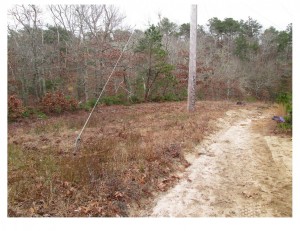
On December 5th the volunteer trail crew of the Brewster Conservation Trust (BCT) pruned 0.3-acre of a 2-acre parcel it owns under NStar’s regional electric transmission lines in East Brewster. The land parcel was donated to BCT by Ruth Jester of Montana in 2008; it abuts the 450-acre Orleans Main Wellfield and is about 1,225 feet from Cliff Pond Well #4.

“We took this action to show Cape Codders that there is positive action we can take to preclude the need for NStar’s herbicide applicators to treat our conservation land,” said Hal Minis, BCT’s President. “We learned that we can remove by hand tools the pitch pines and tree oaks that NStar is rightly concerned about under the powerline. While not everyone who owns property under the powerline has a volunteer crew, we would encourage more people to think of this method as the best low-impact alternative to both mowing and herbicides.”
BCT contacted NStar prior to its treatment of the BCT parcel with hand tools, but had no timely response from the utility.[i] BCT had previously submitted a letter with concerns about spraying its East Brewster properties, two of which have certified vernal pools with breeding salamanders on them. NStar did not respond to that letter either.
NStar spokesman Michael Durand was quoted in a December 7th article in the Cape Cod Times as saying that herbicide application, which has been approved by the State, is “the most effective way to maintain electrical service reliability while at the same time promoting the growth of a self-sustaining meadowland environment.” BCT believes that volunteer hand-pruning is the most effective and low-impact means to maintain the open character of the powerlines, home to rare animals such as box turtles and rare plants such as New England blazing star.
“We recognize that pruning 525 linear feet of powerline may seem insignificant in relation to the hundreds of miles of powerlines NStar may have on the Cape,” said Mark Robinson, Executive Director of The Compact of Cape Cod Conservation Trusts and BCT advisor. “So, is this purely a symbolic gesture? Perhaps. Is it a fool’s errand? No. Land that has been entrusted to our conservation land trusts like BCT deserves to be treated with reverence, both by the land trust that owns it and others like NStar that may have rights to manipulate it. If, as conservation land owners, we can find another way to accomplish NStar’s objectives without resorting to chemical sprays next to wetlands or wellfields, why wouldn’t we?”
Orleans Water Superintendent Todd O. Bunzick met the 11 volunteers of the BCT on December 5th. The Water Department had recently cleared the powerline through the Wellfield in expectations that NStar would bypass spraying there. “I think our stretch of powerline is too long to treat by hand,” he said, “But I applaud what you are doing with volunteers on the BCT land next door. Anything that landowners can do to reduce the extent of the spraying has to be a good thing, in my opinion.” Robinson noted that the Orleans Wellfield is the single largest wellfield parcel on Cape Cod.
BCT Trustees Hal Minis, Pat Bertschy and Bonnie Newman organized the 11 volunteers, whose median age is 68 years old. “We all have strengths and frailities,” said Minis, “But if our crew could accomplish this much good work in 90 minutes, imagine how much could be accomplished if other civic groups or homeowners themselves took to the task.” Minis noted that his crew is only available for work on BCT-owned parcels, for liability and practicality reasons. Other groups such as Americorps may be available for publicly-owned property under the powerlines. Robinson wondered about school groups and teams, particularly high school seniors needing community service credit.
“I guess what it comes down to is that there is a “third way” to address this issue,” said Minis. “We oppose the spraying in sensitive areas. And we think mowing without care to timing and habitat needs can cause problems as well. Using hand tools with knowledge of what to cut and what to keep really is the best method.”
BCT cut pitch pine saplings and tree oak sprouts (black oak and white oak) within 50 feet of the transmission line. Roots were removed as much as possible to prevent re-sprouting. Other low-growing plants that were found and avoided included low-bush blueberry, bearberry, bunch grasses, bayberry, and trailing arbutus, or mayflower, the state flower. BCT noted that NStar has no plans to spray these low-growing shrubs and groundcovers. The cuttings were piled to the side of the right-of-way at the forest edge. Small brush piles create their own habitat niches, providing cover for birds and small mammals such as rabbits.
BCT expects to finish the second half of this property early in January as weather permits. BCT will extend its pruning treatment to other properties it owns in the vicinity and two parcels under the powerlines in West Brewster, which NStar expects to spray in upcoming years. At least one of BCT’s West Brewster powerline parcels is in a neighborhood that still relies upon private domestic wells for drinking supply and hosts the rare New England blazing star flower.
[i]BCT sent an email to NStar on November 22nd indicating its wish to conduct its own non-herbicide vegetation management on the land the trust owns along NStar’s right of way. NStar’s Michael Durand sent an initial reply that the company’s vegetation management and environmental staff would get back to BCT. However, BCT failed to receive any additional communication from the utility company, despite a follow-up inquiry from BCT on December 3rd.


